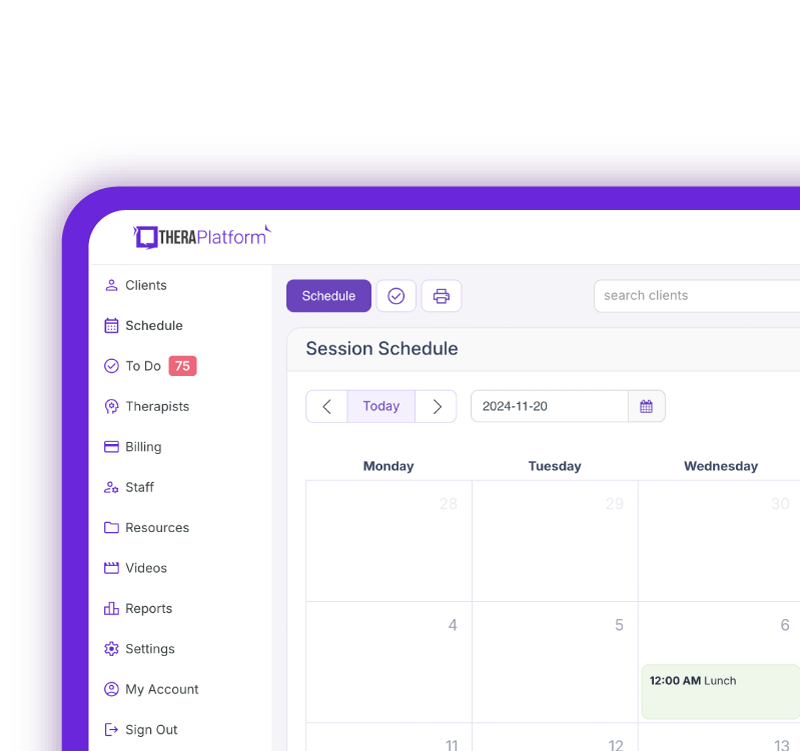Group practice scheduling

Patient appointment scheduling is best implemented in an efficient, streamlined manner and can significantly support the success of a group therapy practice.
Summary
- Efficient patient appointment scheduling enhances operational effectiveness, improves client satisfaction, and supports therapeutic outcomes by ensuring consistent attendance.
- Group therapy practices must balance individual and group sessions while accommodating therapist availability and client needs. An integrated approach can help manage these complexities.
- Transparent scheduling policies, defined appointment types, and easy-to-use scheduling systems can reduce confusion, minimize cancellations, and increase client engagement. Download My Free Cancellation and Termination Templates
- Scheduling software like TheraPlatform with features like automated reminders, online booking, and EHR integration can streamline operations, improve accessibility, and reduce administrative workload.
Establishing an efficient patient appointment scheduling process can enhance the operational effectiveness of your group practice, improve client satisfaction, and impact therapeutic outcomes by facilitating more consistent attendance.
Streamline your practice with One EHR
- Scheduling
- Flexible notes
- Template library
- Billing & payments
- Insurance claims
- Client portal
- Telehealth
- E-fax

Therapy group practices may, however, face several specific patient appointment scheduling challenges. From accommodating varying therapist availability to balancing multiple clients’ needs, it’s important for practices to be aware of solutions to these challenges.
This guide will provide actionable strategies that can enhance patient scheduling efficiency that can benefit clients and therapists.
Patient appointment scheduling for group practices
Group therapy scheduling typically requires a unique approach. A typical structure involves balancing individual and group sessions, assigning specific time slots for group sessions. These sessions must also align with both client needs and therapists’ availability.
Balancing individual and group session schedules can present challenges. Clients may have specific preferences and commitments that lead to scheduling constraints. It’s essential that therapists practice effective time management, striving to meet the needs of individual clients while facilitating group dynamics at the same time. Considering both types of sessions through an integrated approach can help facilitate an effective balance.
It’s essential to align therapist availability with group therapy sessions. Be sure that therapists can dedicate time to both individual and group sessions, and that they are not overbooked. This can ensure therapists have the time needed for session preparation and documentation, which can lead to more effective therapy outcomes.
Establishing clear and client-friendly patient appointment scheduling procedures
Develop clear, transparent patient appointment scheduling policies to help clients understand the process and reduce confusion. Include information on how to schedule, cancel, or reschedule appointments. Outline expectations surrounding attendance and communication.
Define specific appointment types, their durations, and cancellation policies. This way, clients know what is expected. They can plan their schedules accordingly, which can minimize the frequency of cancellations.
Implementing user-friendly patient appointment scheduling systems and platforms allows clients to easily schedule, reschedule, or cancel appointments. Streamlining this process through the right platform with a secure client portal can lead to higher attendance rates and engagement.
→ Download My Free Cancellation and Termination Templates
Leveraging technology for seamless patient appointment scheduling
Explore scheduling software that is specifically designed for therapy group practices to improve efficiency. This software typically includes helpful scheduling features such as availability tracking and automated reminders.
Integrating online booking systems can facilitate clients scheduling appointments at their own convenience. By offering this flexibility, group therapy practices may see higher attendance rates and reduced administrative burdens put on staff.
Optimize scheduling software integration with electronic health records (EHR) systems. This ensures that therapists have immediate access to important client information, enhancing the therapy process and avoiding scheduling conflicts on therapists’ schedules.
Practice Management + EHR + Telehealth
Mange more in less time in your practice with TheraPlatform

.
Customizing appointment templates for group sessions
Consider creating standardized appointment templates for various types of group therapy sessions. This can simplify the patient appointment scheduling process and ensure consistency. It can also help improve therapists’ time management abilities and provide them with additional, much needed time to prepare adequately for treatment sessions.
Allocating appropriate time slots and resources for group sessions is important. Ensure that the physical space you have available supports the volume of clients participating in group sessions. It’s also critical to have the necessary therapeutic materials available.
Implement buffer times and transition periods between group sessions to provide therapists with an adequate amount of time to document and prepare between sessions. This can reduce stress, improve the quality of care, and help mitigate scheduling conflicts.
Maximizing therapist and resource allocation
Follow strategies that can help optimize therapist availability and reduce downtime. For example, identify peak times in demand for therapy sessions and adjust schedules accordingly. Stagger appointments to minimize gaps in therapists’ day.
Managing group sizes and compositions effectively can lead to more productive sessions. Determine optimal group sizes by considering factors such as therapy goals and the desired level of interaction among clients and therapists.
Utilize shared resources such as therapy rooms and equipment efficiently to ensure smooth operations within your practice. Therapists should have access to necessary spaces and materials when needed. Consider posting schedules for when shared spaces will be used by therapists, allowing them to remain knowledgeable about their available resources.
Free Resources for Therapists
Click below and help yourself to peer-created resources:

Implementing reminder systems and follow-up procedures
- Implementing appointment reminders can reduce no-show and cancellation rates significantly. Appointment reminders can be sent through email, text, or phone calls. This can ensure clients and caregivers are prepared to attend or reschedule sessions as needed.
- Utilize multiple channels of communication for appointment reminders to ensure clients can be reached and can communicate with the therapy staff through their preferred method.
- Establish follow-up procedures for rescheduling missed group sessions to help maintain continuity of care. This can encourage clients to remain committed to their therapy plan and may help them feel supported in that journey.
- Continuous monitoring and adjustment of patient appointment scheduling
- Review patient appointment scheduling processes and trends regularly to identify inefficiencies. Look for patterns in data analysis that suggest adjustments should be made.
- Identifying scheduling bottlenecks can help practices take proactive steps that can streamline operations. This can ensure a mother scheduling experience, both for staff and clients.
- Remember to stay flexible to ensure optimal care and client satisfaction. Be prepared to adjust schedules to accommodate the changing needs of clients and variations in therapist availability.
- Staff training and support for patient appointment scheduling
- Staff training in scheduling procedures and software utilization is critical for ensuring everyone within the practice has a thorough understanding in these areas.
- By providing ongoing education on efficient scheduling techniques, you can empower staff to find innovative ways to optimize scheduling practices. This can ultimately enhance the overall efficiency of the practice.
- Encourage staff to share feedback and valuable insights, as this can enhance the practice’s scheduling processes.
Streamline your practice with One EHR
- Scheduling
- Flexible notes
- Template library
- Billing & payments
- Insurance claims
- Client portal
- Telehealth
- E-fax

Resources
TheraPlatform is an all-in-one EHR, practice management, and teletherapy software built for therapists to help them save time on admin tasks. It offers a 30-day risk-free trial with no credit card required and supports mental and behavioral health, SLPs, OTs, and PTs in group and solo practices.
More resources
- Therapy resources and worksheets
- Therapy private practice courses
- Ultimate teletherapy ebook
- The Ultimate Insurance Billing Guide for Therapists
- The Ultimate Guide to Starting a Private Therapy Practice
- Insurance billing 101
- Practice management tools
Free video classes
- Free on-demand insurance billing for therapist course
- Free mini video lessons to enhance your private practice
- 9 Admin tasks to automate in your private practice
References
Briggs, M. S., Ulses, C., VanEtten, L., Mansfield, C., Ganim, A., Hand, B. N., & Quatman-Yates, C. C. (2021). Predictive factors for patients’ failure to show for initial outpatient physical therapist evaluation. Physical Therapy, 101(5), pzab047. DOI: https://academic.oup.com/ptj/article/101/5/pzab047/6124132
Osagie, O. E., Emeka, O. F., & Beatrice, E. (2023). Outsourcing benefits and complications. BW Academic Journal, 9-9. DOI: https://bwjournal.org/index.php/bsjournal/article/view/1363
Wilson, C., Jones, A., Schick-Makaroff, K., & Kim, E. S. (2023). Understanding the impact of group therapy on health-related quality of life of people with Aphasia: a scoping review. Speech, language and hearing, 26(2), 88-101. DOI: https://www.tandfonline.com/doi/full/10.1080/2050571X.2021.1917216



